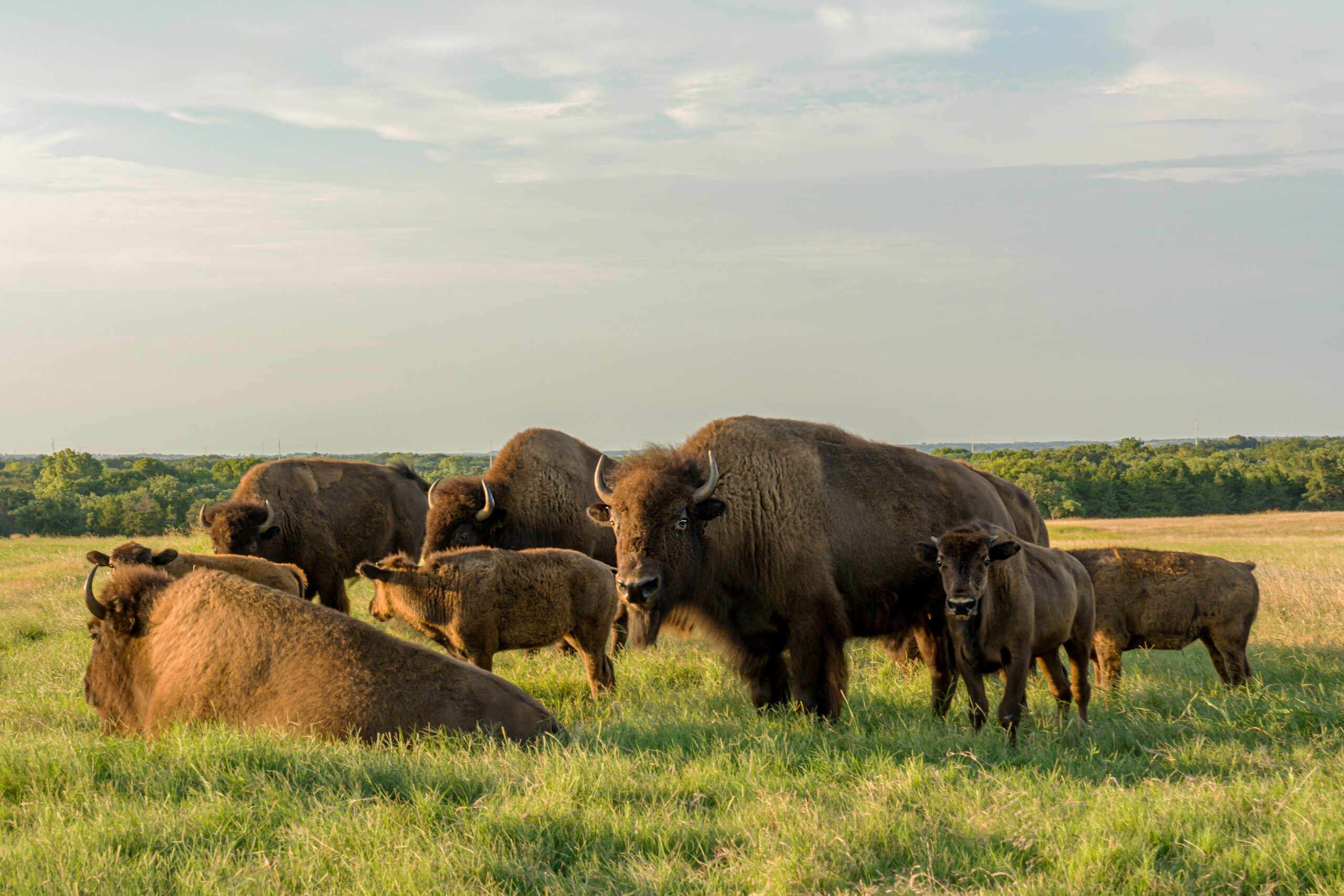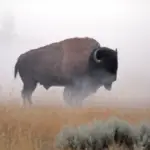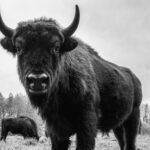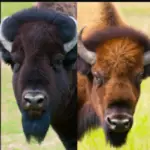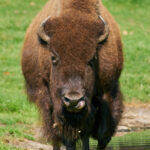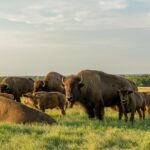Understanding Bison Distribution
Bison, also known as American buffalo, have a fascinating historical range that extends across several states in the United States. These majestic creatures once roamed freely in vast numbers, covering vast areas of North America. The historical range of bison spanned from Alaska and Arizona in the west, all the way to North Dakota, South Dakota, Wyoming, Montana, Oklahoma, and Utah in the central and western parts of the country.
Modern-day distribution of all bison
Today, efforts have been made to preserve and reintroduce bison populations across the United States. While their numbers have significantly decreased compared to their historic populations, bison can still be found in several states. The current distribution of bison includes Alaska, Arizona, Utah, Montana, Wyoming, Oklahoma, North Dakota, and South Dakota.
Explaining the historical range of bison
Bison were once highly abundant and could be found in a wide range of habitats throughout the United States. Their historical range was determined by their adaptability to various ecosystems, including grasslands, prairies, and forests. Bison populations thrived in the Great Plains, where they roamed in large herds, grazing on the vast grasslands. Additionally, they could be found in the mountainous regions of the West, including parts of Alaska and Arizona.
How human development impacted bison populations
The expansion of human settlements and the development of infrastructure had a significant impact on bison populations. As pioneers and settlers moved westward, bison became targets for hunting and their habitats were gradually destroyed. Bison were hunted extensively for their meat, hides, and other resources, leading to a rapid decline in their numbers. The construction of railroads and the conversion of natural habitats into farmland further contributed to the reduction of bison populations.
Bison in Alaska
Understanding Alaskan wild bison
Alaska is home to a unique population of wild bison. Unlike their counterparts in the lower 48 states, Alaskan bison are thought to have crossed the Bering Land Bridge from Asia thousands of years ago. These bison are known as Wood Bison and are larger than their Plains Bison relatives. They have adapted to the harsh climate and rugged terrain of Alaska, making them a remarkable species to observe.
Efforts to preserve bison in Alaska
The Wood Bison faced near-extinction in the early 20th century due to overhunting and habitat loss. However, dedicated conservation efforts have led to their recovery in Alaska. Organizations, such as the Alaska Department of Fish and Game, have implemented measures to protect and restore the bison population. Hunting regulations and habitat restoration initiatives have been instrumental in preserving these magnificent creatures.
Best places to see bison in Alaska
To catch a glimpse of Alaska’s impressive Wood Bison, there are a few key locations to visit. The Delta Junction Bison Range and the Alaska Wildlife Conservation Center are popular destinations that offer opportunities to observe these fascinating animals in their natural habitat. These locations provide visitors with the chance to learn about the conservation efforts and the importance of preserving bison in Alaska.
Bison in Arizona
Characteristics of the Arizona bison
Arizona is home to a unique population of bison known as the Grand Canyon bison. These bison are descendants of the Plains Bison that were introduced to the area in the early 20th century. They have adapted to the semi-arid climate and rugged terrain of Arizona, becoming an integral part of the state’s diverse wildlife.
Where to find bison in Arizona
The largest population of bison in Arizona can be found in the House Rock Wildlife Area, located near the northern rim of the Grand Canyon. This area offers visitors a chance to see the iconic bison against the stunning backdrop of the majestic canyon. Additionally, the Raymond Wildlife Area and the Raymond Ranch in northeastern Arizona also provide opportunities to observe bison in their natural habitat.
Bison in Utah
Significance of bison in Utah
Bison hold great significance in Utah’s history and cultural heritage. In the past, bison were instrumental in the livelihoods of Native American tribes, providing food, clothing, and other essential resources. Today, bison continue to contribute to the state’s natural ecosystem, playing a vital role in maintaining healthy grasslands and promoting biodiversity.
Conservation initiatives for Utah’s bison population
Utah has taken active steps to preserve its bison population and their habitats. State and federal agencies have implemented conservation initiatives that focus on preserving and restoring bison herds. Efforts to protect important migration corridors and establish protected areas have been crucial in ensuring the long-term survival of bison in Utah.
Bison in Montana
Role of bison in Montana’s ecosystem
Montana is known for its vast landscapes and rich biodiversity, and bison are an essential part of this ecosystem. Bison play a critical role in the state’s grassland ecosystems by acting as natural engineers. Their grazing patterns promote the growth of diverse plant species and help maintain the overall health and productivity of the grasslands.
Iconic bison herds of Montana
Montana is home to some of the most iconic bison herds in the United States. The largest free-roaming bison herd in the country, the Yellowstone bison herd, resides in Montana’s Yellowstone National Park. This herd is a living symbol of the West and a testament to Montana’s commitment to bison conservation. Additionally, the National Bison Range in western Montana provides another opportunity to observe these majestic animals thriving in their natural habitat.
Bison in Wyoming
The legacy of bison in Wyoming
Wyoming has a rich history intertwined with the presence of bison. Prior to European settlement, large herds of bison roamed across the plains of Wyoming. They were a vital resource for Native American tribes, providing sustenance and materials for their way of life. Today, bison continue to hold a special place in Wyoming’s cultural heritage and play a significant role in the state’s conservation efforts.
Wyoming’s contribution towards bison conservation
Wyoming has been dedicated to the conservation and preservation of bison populations. The state actively manages and promotes the recovery of bison herds through habitat protection, population monitoring, and collaborative efforts with various stakeholders. Wyoming’s commitment to bison conservation is evident through initiatives such as the State’s Bison Management Plan and partnerships with tribal nations to support bison recovery on their lands.
Bison in Oklahoma
How Oklahoma supports its bison population
Oklahoma has a thriving bison population, thanks to the state’s commitment to supporting their conservation and well-being. The state has established protected areas, such as the Wichita Mountains Wildlife Refuge, where bison can roam freely and thrive in their natural habitat. Oklahoma’s ranchers and landowners also play a crucial role in supporting bison populations by implementing sustainable grazing practices that benefit both the animals and the environment.
Impact of bison on Oklahoma’s landscape
Bison have had a profound impact on Oklahoma’s landscape. Their grazing habits help maintain healthy grasslands, enhance soil fertility, and support a diverse range of plant and animal species. Bison have become an integral part of the state’s ecosystem, contributing to the overall health and resiliency of Oklahoma’s natural habitats.
Bison in North Dakota
Cultural importance of bison in North Dakota
Bison hold immense cultural and historical significance in North Dakota. Native American tribes, such as the Sioux and Mandan, have long revered the bison as a sacred animal and a vital source of sustenance. Today, bison continue to be a symbol of resilience, cultural heritage, and the deep connection between Native peoples and the land.
Status of bison herds in North Dakota
North Dakota is home to several bison herds, both in protected areas and on tribal lands. Theodore Roosevelt National Park serves as a haven for bison, providing them with a protected habitat where they can thrive. Additionally, bison can be found on tribal lands, where tribes actively manage their herds and promote the cultural importance and ecological benefits of bison conservation.
Bison in South Dakota
South Dakota’s thriving bison industry
South Dakota has a thriving bison industry that contributes to the state’s economy and cultural heritage. The state is home to numerous bison ranches, where these animals are raised for their meat and other products. Bison ranching has become an integral part of South Dakota’s agricultural landscape, providing sustainable food options and supporting local economies.
Famous bison locations in South Dakota
South Dakota boasts several iconic locations where visitors can witness the magnificence of bison in their natural habitat. Custer State Park, located in the Black Hills, is home to one of the largest publicly owned bison herds in the world. The park offers scenic drives and wildlife viewing opportunities, allowing visitors to observe bison up close. The Wind Cave National Park also provides the chance to see bison roaming freely in a captivating underground landscape.
Which States in America Have the Largest Bison Population?
Did you know that the bison population in america is spread across several states? Among them, Montana, Wyoming, South Dakota, and Alaska are known to have the largest bison populations. These states provide vast natural habitats for these magnificent creatures, allowing them to thrive and contribute to the rich biodiversity of our country.
Future of Bison across United States
States undertaking bison reintroduction programs
Several states across the United States have implemented bison reintroduction programs to restore and expand bison populations. These programs aim to reintroduce bison to their historical habitats, enhance biodiversity, and promote the cultural, ecological, and economic value of these iconic animals. States like Texas, Nebraska, and Colorado have partnered with conservation organizations and tribal nations to reintroduce bison and secure their future in the American landscape.
Challenges facing bison populations across the country
While there have been significant strides in bison conservation, various challenges still pose risks to their populations. Habitat loss, fragmentation, disease transmission, and genetic diversity are among the key issues that need to be addressed. Collaboration between federal and state agencies, tribal nations, conservation organizations, and local communities is crucial to overcoming these challenges and ensuring the long-term survival of bison.
Role of federal and state parks in preserving bison
Federal and state parks play an essential role in preserving bison populations and their habitats. These protected areas provide secure habitats for bison to thrive, free from hunting and other human disturbances. Additionally, parks serve as educational platforms, raising awareness about the importance of bison conservation and promoting responsible stewardship of natural resources.
In conclusion, the distribution of bison across the United States is a testament to their resilience, cultural importance, and ecological significance. Efforts to preserve and restore bison populations in various states, including Alaska, Arizona, Utah, Montana, Wyoming, Oklahoma, North Dakota, and South Dakota, demonstrate the commitment to their conservation. Through collaborative conservation initiatives, the future of bison in the United States looks promising, ensuring that these iconic animals will continue to roam across the American landscape for generations to come.

